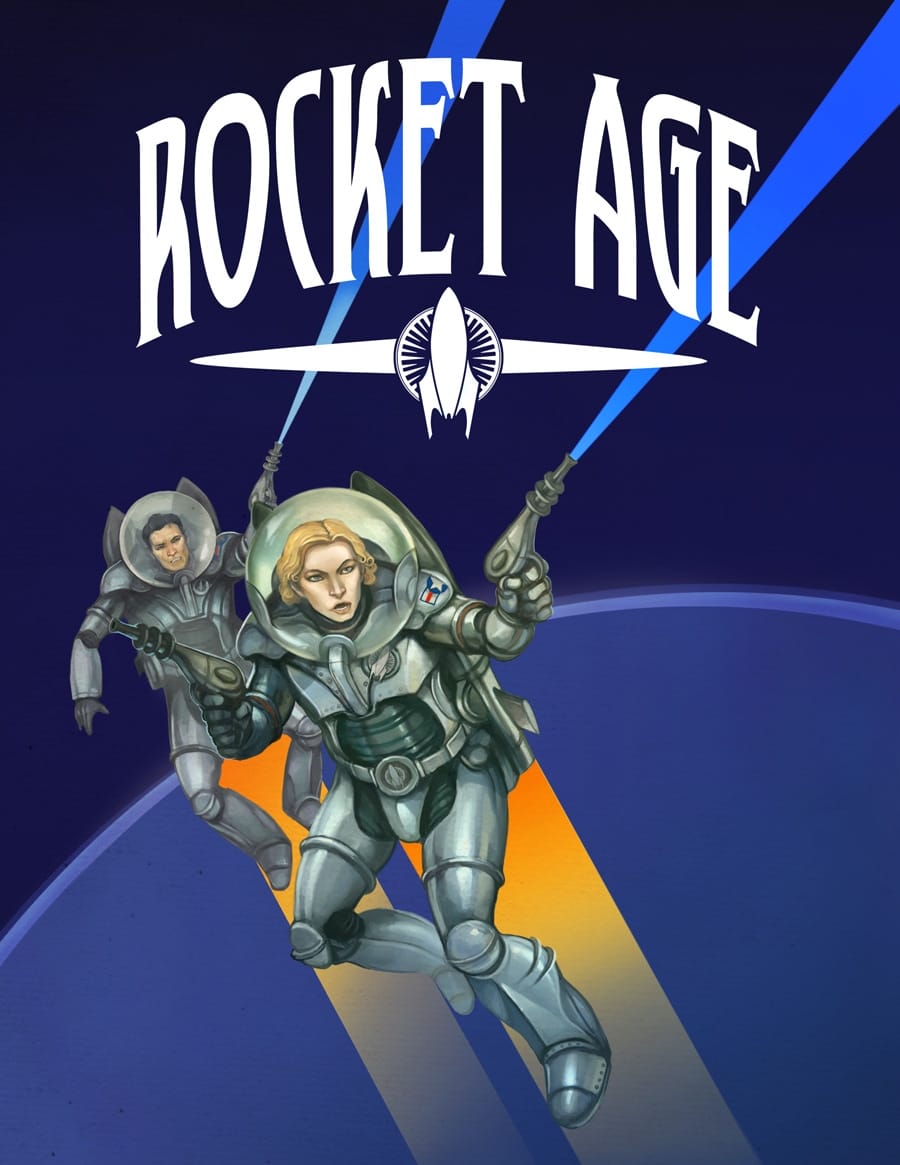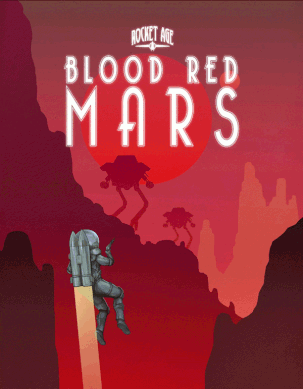
Rocket Age on RPGNow
Rocket Age embraces the science fiction of a century past and the radio dramas of the 30s, the likes of Buck Rogers, Flash Gordon, and John Carter, blended with the pulp action heroics of characters like Doc Savage or Allan Quatermain. Heroes of the new colonial frontier, varied personalities seek to hunt, explorer, unearth and exploit the riches and life of the inner solar system.
This is a long review of both Rocket Age and Martian supplement Blood Red Mars – so, in summary, this is a solid game built on a platform of familiar setting components and the story-focussed Vortex system. Instead of wrong-footing GM and players alike with hundreds of pages of unfamiliar background and setting to digest and absorb, Rocket Age shoots for the Pulp thrills and Nazi-battled shenanigans of books, films, TV and radio series we’re all too familiar with – and that’s a brilliant move.
Like kids in the park making up games and stories around their favourite series with a common understanding of who to play as and what to do, Rocket Age says ‘You know where we are and what’s going on, so get out there now, take your rockets and ray guns with you, and play!’.
Form
Rocket Age is a core book for retro sci-fi adventure, written by Ken Spencer and published by Cubicle 7. You can pick the game up as either a physical hardback book or in PDF format – the latter of which I’m using as the basis for this review.
The PDF runs 257-pages in length, with colour cover, black-and-white interior art, and a two-page index. The PDF has electronic bookmarks, as well as a ‘manual’ Table of Contents and index.
Features
Rocket Age serves as the core book for the game, with enough information and mechanics to get you up and running. Roughly speaking, the document breaks down into thirds – covering setting, character creation and game system, with a small fourth section of Gamemaster Advice tagged on at the end. In practice, players should only have free access to the section on Character Creation, and might take an interest in Game System. The background covered in Part One includes a plethora of character motivations and story hooks, so the GM should measure access to what the character might reasonable need to know.
The book kicks off with the key premise – which makes Rocket Age an alternate history to our own – that Einstein, Tesla and Goddard invented viable space propulsion technology in the early 1930s, taking the fractious factions of Earth out to the stars. Technology and politics mean, thus far, only the inner Solar System, up to the asteroid belt, has been reached in significant numbers.
Tour of the Solar System
Following a brief overview of technology, history, the Great Powers, a Timeline, and a rough guide to the intelligent species of the inner Solar System, Rocket Age sets the stage for the first third of the book. Given the inner system focus, the bulk of those pages cover the main features and geographical draws of Mars, then Venus, Jupiter, and the rest to a far lesser extent and detail.
Each planetary overview doesn’t shy away from what might be considered stereotypical views, familiar to anyone who has read the previous referential fiction. So, for example, Venus has the familiar jungles seen in the works of Burroughs, Heinlein, Bradbury, Moore and others. That’s absolutely not a bad thing to find Mercury a searing hellworld or Mars choked with desert sands, as it means you have more than a century of source material – much of it freely available through the likes of Project Gutenberg or similar archives. While something completely original might appeal to those wanting to explore the unfamiliar, the Pulp-stylings of Rocket Age – to my mind – benefits from that touch of ‘tradition’ (if that’s remotely an appropriate term).
Each planet includes descriptions of key settlements, sites and areas, each with three Story Hooks and a key personality. In each case, the personalities don’t necessarily represent the most powerful or significant – but, they might have the best potential as a plot seed in their own right. I loved the Major in Livingston Lodge, who immediately had me thinking of his doddering namesake from Fawlty Towers. Each personality has a few paragraphs of background to provide a better view of their upbringing, drives, wider motivations and current goals.
Mars – which gets a great deal more coverage in the supplement Blood Red Mars, covered below – has the full range of colonial powers warring across the surface, while the caste-fragmented Martians concede, struggle or outright rebel. We have the Americans who came in peace but now shoot to kill, efficiently brutal Nazi Germans, inefficiently mismanaging Italians, Communist railroading Russians, and a nomadic guerilla army of rabble-rousing Martian nobility – amongst others. The British have taken to Mars like an opportunity to revive the heyday of the Raq, a chance to right the wrongs, undermined by bureaucratic corruption and blinkered racism.
All areas from the Asteroid Belt and beyond have shorter coverage, but as much potential for adventure. Each also has hooks and includes aliens like the imperious Europans, enigmatic creatures of changeable and puzzling purpose, the mobile fungal Ganymedians, and the amphibious H’ykar of Titan. Certainly enough to get started with, even if some of the hooks seem somewhat tenuous in their potential.
Character Creation
Rocket Age uses the Vortex System, the same mechanics that drive Primeval and Doctor Who: Adventures in Time and Space. While the previous systems focus on largely human characters with non-humans as an exception, Rocket Age makes selection of a Species Package a must have restriction, along with the standard need to have at least one point in every basic Attribute.
The Vortex System uses a point allocation method for character generation, with six Attributes covering raw abilities, Skills providing modifiers for expertise, and Traits filling out advantages and disadvantages ranging across occupational, cultural, biological, technological and others. Attributes have a ceiling that means specific species cannot raise abilities beyond that level – so, a slender and frail species might have a low Strength ceiling, while the bullish and brutal will not have the option for high scores in Ingenuity or Awareness.
At a basic level Species sets a few parameter – like essential Skills, key Traits and Attribute thresholds – but otherwise doesn’t consume much of the pool available for character generation. It does provide some foundational form characters from the outsight, suggesting where strengths and weaknesses might lie. It means that players won’t flounder in the setting without any sense of guidance.
Getting a character up and running simply means choosing a high concept, selecting a Species that fits what they’re keen to play, and then the player has free rein to customise to their heart’s content. If they still desire some structure and opt to let the book guide their design, the book also offers a whole section of optional Occupations, fifteen in total, each with a package cost, that designate Attributes, Skills and Traits. All occupations serve as a broad strokes structure to guide point expenditure – so, a Citizen, for example, might be anything from a journalist through a haughty butler to a dilettante on The Grand Tour of the inner Solar System.
Part Two then goes on to outline sections on other character elements and facets, with a section apiece on Attributes & Skills, Traits and Equipment (after all, what’s a Rocket Age character without a silvery suit and a RAY gun?). Traits, for both characters and equipment, have commonality across the different games running the Vortex System, so you’re open to bring in favourites from Doctor Who or Primeval – if they not included here already.
Game System
When it comes to the dynamics and fluidity of the game, the clues in the title – Rocket Age. You don’t want to get bogged down in crunch and calculations when you’re fighting a desperate battle against a squad of Nazi Panzerschreiter war walkers. However, when fates hang in the balance and fortune might yet favour the brave, this section provides the mechanics to resolve conflict.
The basic system involved rolling 2 six-sided dice, then adding an Attribute, relevant Skill and any other modifiers. The six Attributes have a fairly broad range of coverage and you can align Skills with anything reasonable, so if the GM hasn’t given it much thought, players can easily suggest combinations when a situation arises. Roll the dice, add the modifiers, and if you equal or exceed the Difficulty set by the GM, you succeed.
As well as straight successes and failures, the Vortex System also allows for Degrees of Success that add to the storytelling potential of conflicts. If you roll within 3 of the target, it’s a …But – a success or failure that runs so close to the mark that something happens but not quite the ideal. Roll 9 or more, above or below, and you achieve an …And result – a success or failure that manages to deliver something unexpected or unforeseen. A success might provide some additional clue, an advantage you can carry forward, or just an extra splash of damage. A failure might put you in a strategical worse position, snap your tool, waste ammo, or just hurt you when you meant to hurt the enemy!
As well as contests, cooperation and extended rolls, the section includes plenty of worked examples and reference of possible approaches and combinations. I appreciate the ease of the system when I first read it in Doctor Who – and it remains simple, accessible and straightforward here. It’s about using the mechanics to drive play, enhance story, and support description. The numbers never get in the way – they just resolve doubt when chance matters and success isn’t certain.
To enhance the potential for player characters to emerge as real heroes, Story Points provide them with a currency to influence the flow of the plot. Players can choose to spend them to get a clue when they’re stuck, escape certain death by the skin of the teeth, add extra dice to increase potential for success, shrug off serious injury as a messy flesh wound, and even bend the plot (an expensive option, but an option nevertheless). Story Points provide the players with some measure of narrative control without stripping out the whole system and just opting to tell stories around the tabletop. Where you want to tell exciting tales, but you’re not comfortable with the chaos of just making stuff up, the Vortex System provides a good middle ground.
On top of the essentials of dice rolling and success calls, the section also cover actions and combat, chases, psychic powers, gadgets, vehicles and experience.
Gamemaster Advice
Often times the section skipped by ‘experienced’ GMs, the short Gamemaster Advice section offers some genuinely useful reminders about the whys and whats of running a fun and successful game. The section also considers the structure of Rocket Age games, and how you might go about putting individual sessions – or Episodes – together. The approach looks to ensure an enjoyable mix of story, action, danger and cliffhanger excitement. The back of the section provides outlines for five Episodes as structural examples in the creation of your own.
Alien Beasts rounds off the book with a dozen beasties – including the ferocious Thunder Lizard, suited to trips through the wilderness, alien zoo escapes and big game hunts. As previously mentioned, the cross-compatibility of the Vortex System means that owning books from the Doctor Who and Primeval series means you’ll have even more options for encounters, friends and adversaries. Rocket Age landscapes have a lot of prehistoric threat about them – so, Primeval should prove especially handy for expanding your repertoire.
Blood Red Mars

Blood Red Mars on RPGNow
While the core book contains a lot of information about Mars, key locations of the Red Planet, and the various branches of the elaborate Martian caste system, Blood Red Mars expands on that considerably.
The 160-page supplement, written by Ken Spencer, explores conflict torn Mars in detail. The book takes in even more locations in a Martian Gazetteer section, then delves down into notable organizations, the savage natives known as Chanari, flora and fauna, new traits, and rounds out with an adventure.
Martian Gazetteer
The Gazetteer offers collaborators, pirates, radicals, Communists, innovators, temple-states, Ancient Martian ruins, Nazis, alien terrorists, stubborn traditionalists, and the home of the Orthodox Fellowship, a key native religious movement. Along with a two-page map of Mars, the section offers up more than 50 provinces of the Red Planet. For completeness it has a brief mention of areas covered in the corebook, but the majority provide new backdrops for adventure, a trio of story hooks apiece, and a key personality. The sheer variety of situations, relationships, conflicts and potential discoveries makes each and every one of them a fine place to setup a campaign – or, perhaps, a better term might be a Season of interconnected Episodes.
Organizations
Organizations runs through various representative ventures and groups associated with the key powers active on Mars. As well as outlining their history, structure, motivations and agents of influence, each organization also outlines a new Occupation – suitable for players or GM-driven adversaries alike. Those seeking inspiration beyond the core rules selection can now opt for agents of the 31st Seal, Buffalo Soldiers of the American Expeditionary Force, or high Martian Duelists. The Organizations each have their own story and character hooks, giving the option to tie both player creations and the course of the campaign into one or more of these diverse political, cultural and religious groups.
The Chanari
This section focusses in on a specific ethnic group of the Martian populace, which I’d best describe as the Martian equivalent of cockroaches. These staunchly traditionalist Martians doggedly clung to a simple nomadic life, even as the Ancients ascended to technological and cultural height not seen since on the Red Planet. When global catastrophe struck, the Chanari weathered the storm and survived, while the Ancient fell into darkness and ruin, altering their culture and potential forever. As well as going into considerable detail on the lifestyle of these tribal Martians, the section serves up more additional options in Occupations and traditional Equipment, like the Bone Ballista and the impressive Fire Lance.
…and the Rest
After Flora and Fauna – which serves up eleven new challenges of the Martian wilderness, with full stats and Story Hooks – New Traits and Equipment provides options for all characters, Martian or otherwise, including a whole many Ancient Martian Artifacts. Amongst the inventions of Nikolai Tesla, the core book included RAY (Radiation Accelerating Weaponry) weaponry, which he adapted from technology discovered on his trips to Mars. The artifacts here include many examples of that original Martian RAY weaponry – more powerful and varied than Tesla’s design, but often difficult to recover from the inaccessible and treacherous ruins of the Ancients.
The book closes out with The Stolen Artifact, a fully detailed episode for two to six players. While you might be thinking this is the first adventure mentioned in this entire review – and you’d be right – I want to emphasize that virtually everything – cultures, occupations, organizations, adversaries – throughout both of these books has a trio of story hooks associated with it. That’s hundreds of ideas to work with and a setting that feels at once familiar – packed with common tropes and stereotypes – and yet filled with original potential. On top of that, Cubicle 7 has released five separate adventures in PDF if you feel you need more guidance and don’t want to just create your own stories from scratch. This includes the 30-page introductory adventure The Lost City of the Ancients, which you can pick up for free, and includes pre-generated characters.
Final Thoughts
Rocket Age serves up a solid story-focussed game of Radium-fuelled Pulp adventure, powered by the simple and flexible Vortex system. Like Doctor Who and Primeval before, Rocket Age makes the most of player and GM familiarity with genre stereotypes, like two-fisted heroes, sleek rocketships, boo-hiss Nazis, and noble, fallen Martians to deliver an effective and satisfying basis for adventure.
The corebook and Martian supplement come filled with background material, but there’s really nothing stopping you skipping to the mid-section of Rocket Age, creating characters and getting straight down to the adventure. Perhaps – just perhaps – some might bemoan this familiarity, the sense of seeing many aspects of this setting before – but I’d suggest that it makes for an accessible and enjoyable experience for all, where the GM can easily get a whole group up and running without the complexities of explaining both the system and the universe, too.
My copy was provided for review. You can get copies of both Rocket Age and Blood Red Mars in physical and electronic formats. Ken Spencer, Cubicle 7. RPGNow PDFS: Rocket Age, $19.99, and Blood Red Mars, $17.99.

